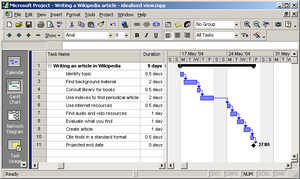Task management software can really make you more efficient and therefore able to

- life cycle of a task
manage your time much more easily. In that case, there are many different task management software programs out there that can help you manage your day. So who would benefit most from task management, and the use of task management software? Read on for more about this.
Many people find themselves at a certain point in their life looking for a task management software to help them refocus and keep their finger tips on what is important. Task management products organize, schedule and ensure that tasks get done on time. On short it can boost your productivity. By being better organized and more focused on what you have to do, you save time and reduce stress.
Good task and project management software was hard to find a few years ago when people were using Outlook. Nowadays productivity has become almost an obsession of geeks everywhere, so the increasing request for such tools generated a large base of good task and project management solutions. There are a lot of choices to help manage the tasks, ranging from standalone applications to web-based services.
What exactly are users looking for?
Most of them are actually looking for a personal organizer application to put some order in their busy and messy life. “In the beginning, I somehow managed to keep everything in my head. Then, as I began to take on more projects, I realized that I needed a task management system to keep me organized and focused.” says Deborah Woehr a freelance researcher and writer. These personal organizers generally take the form of the so called “To Do List” applications where users create a list of tasks for which they set a start date, some deadlines and a priority – something very simple.
The Getting Things Done (GTD) methodology
Most of the to-do-list applications these days adopt, to one degree or another, the GTD approach to task management according to the work-life management system by David Allen that provides concrete solutions for transforming overwhelm and uncertainty into an integrated system of stress free productivity. Apps vary as to how tightly or loosely bound to GTD they are. The problem, though, with To Do lists and personal organizers is that are only good for your work. Task management or task tracking software is more than just a to-do list. In a business many of the tasks are collaborative and require multiple team members to fulfill several tasks in a single project. In this case you need an application where assignments could be made, all tasks could be tracked, and completed work could be archived. This is a true task management tool. Users sometimes need to manage multiple projects and delegate work to resources, schedule tasks in time or even create plans. This is a further step to an upper level: project management or project planning software.
Why do we need a task management application?
Every day we spend most of the time on urgent but low priority tasks while the most important ones get delayed until another day. Unfortunately, that “another day” might never arrive. The famous Pareto principle of 80/20 rule applies here: 80% of most important work gets completed if you try to figure out the 20% of high priority tasks. Basically an effective task management software must give you the best way to find these top 20% of important tasks for a effective project management process. This is a major problem with task management applications: they require too much effort on users part. It is easy to spend too much time on organization, and not enough on getting things done. Too many apps spoil the productivity. Task management apps should flow, should make using them easier than writing things down on a piece of paper.
Benefits of a task management tool
- helps you to organize, assign and prioritize tasks
- allows you to establish goals and milestones and to manage deadlines
- no need to remember all tasks and more productivity using reminders
- entire work integration, effort delegation for increased efficiency and reduced costs
- the break down of complex tasks into smaller deliverables that can be controlled with minor difficulty
A task management software is an essential component for organizational and business operations and can make managing the project simpler.




